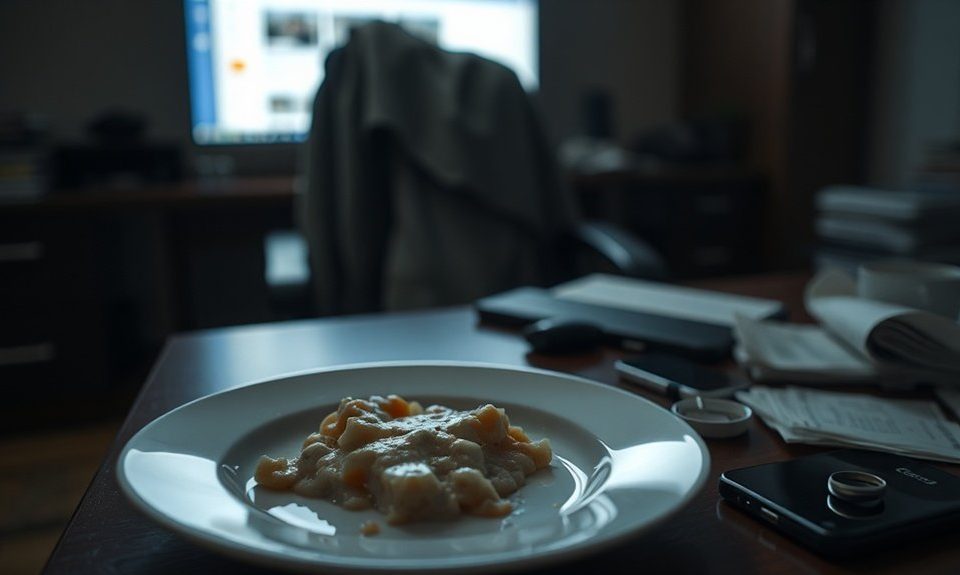Professional private investigators utilize systematic surveillance, digital monitoring, and legal evidence collection to document potential infidelity. Their methods include establishing observation points, tracking social media activity, and gathering admissible documentation of suspicious behavior patterns. Investigators maintain strict confidentiality while collecting photographic evidence, analyzing communication records, and monitoring location data. Following proper legal protocols and maintaining detailed case documentation guarantees the most thorough investigation results.
Key Takeaways
- Document suspicious behavior changes including late work hours, unexplained absences, and sudden password changes on devices.
- Conduct systematic social media surveillance to identify new connections, changed privacy settings, and location check-in patterns.
- Monitor digital footprints through call logs, text messages, and newly installed dating or encrypted messaging apps.
- Establish strategic surveillance operations with proper equipment and observation points to gather photo and video evidence.
- Maintain detailed chronological records with timestamps, locations, and chain of custody for all collected physical and digital evidence.
Legal Guidelines and Professional Boundaries

When conducting surveillance on a potentially unfaithful spouse, private investigators must operate within strict legal parameters to protect their clients and themselves. This includes obtaining proper licensing, maintaining detailed case records, and adhering to state-specific regulations regarding surveillance activities.
Professional investigators establish clear boundaries through confidentiality agreements that outline the scope of services and limitations of their work. They must respect privacy laws, avoid trespassing, and never engage in illegal activities such as wiretapping or unauthorized GPS tracking.
Ethical considerations guide every aspect of infidelity investigations. Investigators must maintain objectivity, avoid emotional involvement, and guarantee their methods don’t escalate domestic tensions. They should also recognize when to decline cases that could compromise their professional integrity or put any parties at risk.
Maintaining data security protocols through encryption and multi-factor authentication is essential when handling sensitive client information in infidelity cases.
Planning Effective Surveillance Operations
Building upon established legal frameworks, successful surveillance operations require meticulous planning and strategic execution. Private investigators must carefully select ideal observation points, determine the most effective surveillance equipment, and establish clear protocols for documenting evidence.
Operation logistics involve thorough assessment of the target’s routines, identifying potential challenges in the environment, and maintaining a discreet presence. Investigators coordinate schedules, establish backup plans, and guarantee all team members understand their roles. They must also account for variables such as weather conditions, traffic patterns, and location accessibility.
The planning phase includes preparing contingencies for unexpected situations, establishing communication systems between team members, and selecting appropriate vehicles and technical tools. This methodical approach maximizes the likelihood of obtaining legally admissible evidence while maintaining professional standards throughout the investigation. Professional investigators often employ covert operations tactics to monitor suspicious behavior while respecting ethical boundaries.
Digital Evidence Collection Methods
A thorough investigation of digital evidence begins with systematic monitoring of the subject’s social media activities, including pattern analysis of posts, check-ins, and online interactions. Mobile device monitoring requires specialized knowledge of data extraction methods, GPS tracking capabilities, and recovery of deleted communications. Professional investigators must remain current with evolving digital forensics techniques while adhering to all applicable privacy laws and regulations. Cell phone forensics experts can retrieve vital evidence from cloud storage services and recover deleted text messages that may indicate patterns of infidelity.
Social Media Surveillance Tactics
Social media platforms have become invaluable sources of evidence in infidelity investigations, offering private investigators a wealth of digital footprints to analyze. Trained professionals understand how to legally monitor public activity across various platforms while respecting privacy laws and ethical boundaries.
- Cross-referencing Instagram privacy settings to identify changes that may indicate hidden content or restricted viewing
- Analyzing Facebook friends lists for new connections, particularly those with frequent interactions
- Documenting patterns in location check-ins, tagged photos, and event attendance
- Monitoring profile picture changes, relationship status updates, and timeline activity
- Examining mutual connections and friend networks for potential leads
Investigators methodically document all findings, maintaining detailed records of timestamps, URLs, and screenshots to establish patterns of behavior that may indicate suspicious activity or relationships requiring further investigation.
Mobile Device Monitoring Tips
Mobile devices serve as digital repositories of invaluable evidence in infidelity investigations, containing call logs, text messages, GPS data, and app usage patterns that can reveal suspicious behavior.
Professional investigators focus on mobile app usage analysis, examining patterns in messaging apps, dating platforms, and location-sharing services. Text message analysis involves reviewing message frequency, timing patterns, and emotional tone indicative of extramarital relationships. Investigators document abnormal spikes in communication, deleted message threads, and the presence of encrypted messaging applications.
Key indicators include late-night text patterns, newly installed dating apps, secondary communication platforms, and location inconsistencies between stated whereabouts and actual GPS data. Success requires meticulous documentation of findings while adhering to applicable privacy laws and regulations governing electronic surveillance.
Social Media Monitoring Strategies
Private investigators frequently examine hidden or restricted friend lists on social media platforms to identify potential secret connections between subjects. Location data from tagged photos and check-ins can reveal patterns of movement and potential meeting locations that may not align with a subject’s reported whereabouts. Cross-referencing these digital breadcrumbs across multiple social platforms helps establish a thorough timeline of a subject’s activities and social circles. Working with Stillinger Investigations’ expertise ensures comprehensive monitoring of all available social media evidence during infidelity cases.
Monitor Hidden Friend Lists
Friend lists on social media platforms can reveal valuable information about a potentially unfaithful spouse’s hidden connections and relationships. Investigators can analyze these lists to identify suspicious patterns in friend interactions and uncover concealed associations.
- Check for recently added friends who appear frequently in likes or comments
- Look for hidden friend lists that have been deliberately concealed from public view
- Monitor mutual friends between suspected parties
- Examine friend lists during specific time periods or locations of interest
- Cross-reference friends across multiple social media platforms
Professional investigators understand that hidden relationships often leave digital footprints through friend connections. By systematically examining these networks, they can identify potential affair partners, establish timelines, and gather evidence of suspicious social media activity. This method proves particularly effective when combined with other social media monitoring strategies.
Analyze Tagged Location Data
Location data embedded in social media posts provides investigators with precise geographical insights into a subject’s movements and routines. When individuals share geotagged images or check into venues, they inadvertently create a digital trail of their activities. Professional investigators analyze this location tracking data to establish patterns and identify potential discrepancies.
| Data Type | Investigation Value | Key Indicators |
|---|---|---|
| Check-ins | Establish routines | Frequent locations |
| Photo tags | Verify presence | Time stamps |
| Stories | Real-time tracking | Location stamps |
Physical Evidence Documentation Techniques
Documenting physical evidence properly requires meticulous attention to detail and a systematic approach. Professional investigators utilize photographic evidence and video documentation to create an undeniable record of findings that can withstand scrutiny.
- Document items chronologically with date, time, and location stamps
- Photograph evidence from multiple angles, including close-up and wide shots
- Maintain proper chain of custody records for all physical items collected
- Use high-resolution cameras and guarantee adequate lighting conditions
- Record detailed written descriptions to accompany visual documentation
When gathering physical evidence, investigators must consider how each item contributes to the overall investigation. This includes preserving receipts, clothing items, correspondence, or other relevant materials. Proper documentation not only supports the investigation’s findings but also guarantees the evidence remains admissible if legal proceedings become necessary. Digital forensics services can provide critical data recovery to supplement physical evidence collection in infidelity cases.
Client Communication Protocols

Professional investigators maintain strict communication protocols when interfacing with clients during infidelity investigations. They establish clear boundaries for client engagement from the outset, defining expectations for frequency, timing, and methods of communication. This structure helps maintain objectivity and protect the integrity of the investigation.
Investigators typically implement secure communication techniques, including encrypted messaging apps and confidential reporting systems. They schedule regular briefings at predetermined intervals rather than responding to frequent client inquiries, which helps manage emotional reactions and prevents interference with surveillance operations. All case updates are delivered factually and without speculation, focusing solely on documented evidence. Written summaries follow standardized formats, ensuring consistent delivery of information while maintaining emotional distance and professional boundaries throughout the investigation process.
Understanding personality type indicators can help investigators better handle client communication styles and emotional responses during infidelity cases.
Case Report Preparation Standards
Meticulous case report preparation requires private investigators to follow strict documentation standards that protect both the evidence chain and client confidentiality. Professional case report formats guarantee findings are presented systematically and thoroughly for legal scrutiny.
- Evidence presentation must include dates, times, locations, and detailed descriptions of observed activities
- Photographs, videos, and audio recordings require proper labeling with metadata and chain of custody documentation
- Digital evidence must maintain original file formats with unaltered timestamps and geolocation data
- Witness statements need verbatim transcription with contact information and willingness to testify
- Surveillance logs should chronicle investigator movements, equipment used, and environmental conditions
These standards help investigators maintain credibility while providing clients with actionable intelligence that meets evidentiary requirements for legal proceedings. Like physiological indicators measured in polygraph examinations, detailed documentation of behavioral patterns and reactions can provide valuable insights into potentially deceptive conduct.
Frequently Asked Questions
How Do I Emotionally Cope With Discovering My Spouse’s Infidelity?
Processing infidelity involves recognizing stages of grief, seeking counseling support, establishing healthy boundaries, and gradually rebuilding trust. Connecting with others who understand these experiences provides valuable emotional validation during healing.
What Are the Warning Signs That My Spouse Might Be Cheating?
Common warning signs include suspicious behavior like guarding phones, unusual work hours, and newfound secrecy. Emotional distance, decreased intimacy, defensive reactions, and sudden appearance changes often indicate relationship concerns.
Should I Confront My Spouse Before Hiring a Private Investigator?
Direct confrontation without evidence can damage relationships and prompt denials. Partners should assess their emotional readiness and consider productive confrontation strategies before taking investigative steps that may prove irreversible.
What Percentage of Suspected Cheating Spouses Are Actually Unfaithful?
Statistics show 70-75% of suspected infidelity cases prove accurate. Relationship trends indicate intuition about a partner’s unfaithfulness is often justified, though confirmation requires substantial evidence beyond suspicion.
How Long Does It Typically Take to Gather Conclusive Evidence?
Evidence collection typically spans 2-4 weeks, though investigation timelines vary based on subject patterns and behavior. Professional surveillance usually requires 20-40 hours to obtain conclusive documentation of activities.
Conclusion
Professional private investigators must maintain strict adherence to legal and ethical guidelines while conducting infidelity investigations. Through methodical surveillance, digital monitoring, and evidence collection, investigators can build thorough cases that meet evidentiary standards. Proper documentation and clear client communication remain essential throughout the process. The investigator’s role is to uncover facts objectively while protecting client interests within professional boundaries.






